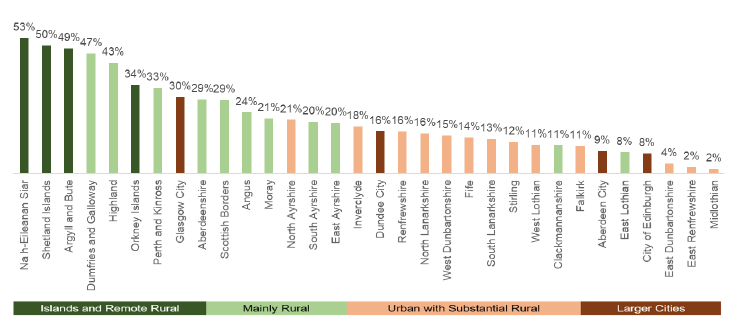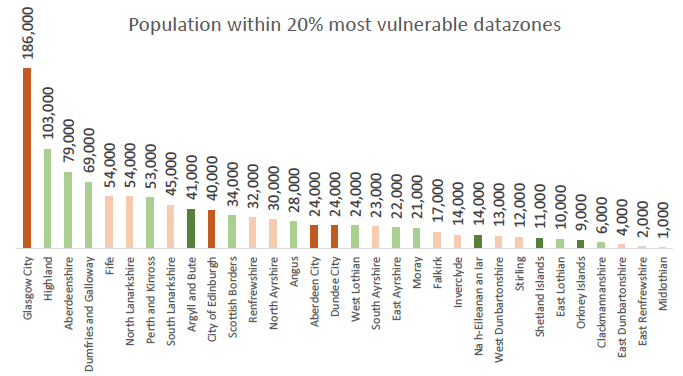Local level Brexit vulnerabilities in Scotland: Brexit Vulnerabilities Index (BVI)
This research identifies areas of Scotland that are expected to be most vulnerable to the consequences of Brexit, and what drives those risks to support local authorities and other organisations in understanding local risks around EU exit.
Executive Summary
Headline findings
This research identifies areas of Scotland that are expected to be most vulnerable to the consequences of Brexit; and what drives those risks to support local authorities and other organisations in understanding local risks around EU exit. It analyses data on eight variables and produces a Brexit Vulnerability Index score for nearly 7,000 different areas (datazones) in Scotland. An accompanying interactive map allows for more granular analysis of each datazone in Scotland. It can be accessed from https://bit.ly/30W1UVQ
Key findings are that:
- The risks presented by Brexit are anticipated to have significant social and economic consequences for all areas of Scotland.
- Many of the areas most vulnerable to Brexit are in rural locations, in particular on the Scottish islands. Around half of communities in Shetland Islands, Na h-Eileanan Siar, Argyle & Bute and Dumfries and Galloway are amongst the most vulnerable communities in Scotland (20% most vulnerable datazones).
- On Na h-Eileanan Siar there are nearly 14,000 people in the most vulnerable datazones in Scotland. Likewise, on the Shetland Islands there are more than 11,000 people in the most vulnerable datazones.
- A smaller proportion of areas within cities and large urban areas are found to be in the most vulnerable 20% of datazones in Scotland. However, because the urban population is substantially larger than the rural one, there are still high numbers of people in urban and suburban areas who live in such locations. For example, there are 186,000 people in Glasgow alone and nearly 170,000 people in Fife, North and South Lanarkshire and Edinburgh combined who are living within the most vulnerable datazones in Scotland.
Background
The UK's departure from the European Union (Brexit) poses a complex range of challenges for communities across Scotland. This paper identifies a number of factors which will influence a community's vulnerability. The analysis does not anticipate a specific Brexit scenario. Instead, it starts from the assumption that leaving the EU will create a number of challenges, and that whilst different Brexit outcomes may influence the scale of these challenges, the underlying drivers will be similar. The research takes the following approach: firstly, the factors which make an area vulnerable to Brexit are identified; and secondly, these individual factors are combined into a Brexit Vulnerabilities Index highlighting across Scotland the areas that may be most at risk.
Factors contributing to Brexit vulnerability
Previous Scottish Government analysis has set out the short-term impact that would be caused by a No Deal Brexit and the long-term implications that future trading arrangements post Brexit could have on the Scottish economy.[1] This analysis demonstrates that a No Deal Brexit would risk causing a significant economic shock, whilst any agreement is likely to result in GDP, disposable income and business investment all being lower than if we remained in the EU.
The trends driving these impacts are often operating at a UK or international level. However, they will have local impacts and consequences which will vary significantly across Scotland.
Constructing a Brexit Vulnerability Index
Scotland's communities are not homogeneous, and it is important to understand the different implications and transmission mechanisms via which Brexit will impact on different parts of Scotland. This can be done by assessing the extent to which the characteristics of different communities makes them more or less vulnerable to the implications of Brexit.
The Brexit Vulnerability Index has been constructed for nearly 7,000 different datazones in Scotland.[2] This index groups together a number of different indicators of exposure to the risks associated with Brexit to provide an overall assessment for each community in Scotland.
Eight variables are used to construct the index, capturing the following factors:
- Access to Services;
- Share of the population of working age;
- Income deprivation;
- Population Change;
- Workers in Brexit sensitive industries;
- EC Payments received (a) CAP,
- EC Payments received (b) ESF/ ERDF; and
- EU Worker Migration.
The variables are then weighted and combined together to form a single indicator for each datazone in Scotland – the Brexit Vulnerability Index.[3] The results can then be used to identify the datazones which are believed to be most vulnerable to the challenges which Brexit represents. An interactive map is available at https://bit.ly/30W1UVQ which allows the results for individual datazones to be easily identified. The underlying dataset used to produce the analysis is also provided online to allow users to understand how varying underlying assumptions can impact on the overall results[4]. The interactive map is designed to support local authorities' and other organisations in understanding local risks around EU exit and to complement their wider knowledge and analysis. Whilst results are provided for individual datazones, these should not be viewed in isolation. The risks that an individual datazone faces will depend on a range of wider factors such as the vulnerability of the wider region in which is it located, commuter patterns and unique local characteristics.
Results
The analysis shows that areas in every local authority in Scotland are exposed to the risk that Brexit represents. However, more rural areas appear to be of proportionately greater risk. For example, in Na h-Eileanan Siar 53% of communities at datazone level are within the 20% most vulnerable communities in Scotland; 50% of those in the Shetland Islands, 49% of those in Argyll & Bute and 34% of those in the Orkney Islands. This equates to around 75,000 people. This generally reflects the high concentration of the workforce in Brexit vulnerable sectors such as fishing and agriculture in these areas; relatively high European funding receipts and rurality, all of which are believed to increase a locations vulnerability to Brexit.
A higher proportion of rural locations are contained within the 20% most vulnerable datazones in Scotland than are more urban locations. This does not mean that urban areas are not vulnerable, but that in aggregate rural communities are typically relatively more exposed to the risks that Brexit represents. Moreover, within Scotland's cities there are a large number of areas which are highly vulnerable to Brexit and have large populations. For example, within Glasgow 186,000 people live within the 20% most vulnerable datazones in Scotland. Likewise, 170,000 people in Fife, North and South Lanarkshire and Edinburgh live in the most 20% most vulnerable datazones. Both in Dundee and in Aberdeen cities around 24,000 people live in the most vulnerable areas. We can see that in Figure 1 below, which shows the distribution of the 20% of datazones identified as being most vulnerable to Brexit by Scottish local authority, split by the RESAS Classification for the rural economy.[5]
Figure 1 Shares of most Brexit vulnerable datazones by local authority

The areas that have comparatively lower concentrations of Brexit vulnerabilities are Midlothian, East Renfrewshire, East Dunbartonshire, and Edinburgh. Such local authorities share several characteristics: all are located on or near the central belt and have relatively diversified economies. All have had significant population growth over the past decade which helps shelter them against depopulation vulnerabilities and have relatively low levels of deprivation. However, all still contain large populations which will be very vulnerable to Brexit, as shown in Figure 2 below.
Figure 2 Population in 20% most vulnerable datazones in Scotland by local authority

Looking at the same local authority areas as in the paragraph above they have populations of around 1,500 in Midlothian, 2,200 in East Renfrewshire, 4,500 in East Dunbartonshire, 6,000 in Clackmannanshire and 40,000 in Edinburgh within the 20% most vulnerable. Clearly though the largest numbers of the most vulnerable communities are in Glasgow, the Highlands, Aberdeenshire, and Dumfries and Galloway.
Contact
Email: ruralstatistics@gov.scot
There is a problem
Thanks for your feedback